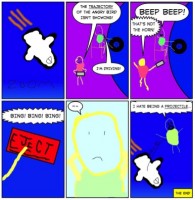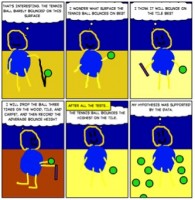
Author: Aileen Hower (South Western School District, Hanover, PA)
Digital tools that have proven helpful in supporting students on the autism spectrum to express their thoughts better in writing are those that allow them to create comic strips or illustrations. Sites like Bitstrips – www.bitstripsforschools.com, MakeBeliefsComix – www.makebeliefscomix.com, ComicLife – www.comiclife.com, or ToonDoo – www.toondoo.com, help students who can be reluctant writers. While students still meet the requirement to share their thoughts in writing, less overall writing is required, while the same amount of depth of thought remains. Also, with students who typically struggle to express complete thoughts in writing, an illustration adds a visual (symbolic) representation to any written product, thereby allowing the student to show in a more sophisticated manner, what they understand. Having to add a picture to the writing supports the development of the student’s nonverbal language skills as well. Finally, students can tap into their artistic talent to show their knowledge, which increases their motivation for completing work. It also helps them feel successful in the classroom.
The following is an example of a student completing a vocabulary study of the root, “-ject”:
Cartooning allows for a more interactive and dynamic way to study vocabulary and express knowledge learned. An additional benefit to the work is how it shows the student’s humor, which is not clearly expressed in person. This work was created using Bitstrips by a student on the autism spectrum.
Comic strips and illustrations can also be used to show learning in the content area. The following is an example of how a student created work on Bitstrips to express his understanding of the scientific method:
In this work, the student’s use of a text box to show the passage of time is a sophisticated expression of detail in writing to describe this experiment.
Students on the spectrum need a digital tool such as a cartoon/illustration-creator to be able to engage in this type of creative expression of their understandings of information. Allowing students to use such tools will enhance their engagement and their willingness to share what they know with their teacher. Moreover, students who are learning English as their second language can use these digital tools to incorporate visual information into assignments, as can any students who are strong in their visual expression.
About the author: Aileen P. Hower (aileen.hower5@gmail.com), is an ILA member since 2008, and an ILA Technology in Literacy Education-Special Interest Group (TILE-SIG) member since 2014. She earned her doctorate in reading/language arts leadership from Widener University, is a K-12 literacy supervisor for South Western School District in Hanover, PA, and serves as an adjunct reading instructor for Penn State University and Cabrini College (Radnor, PA). She is an executive board member of the Keystone State Reading Association and their social media coordinator.

